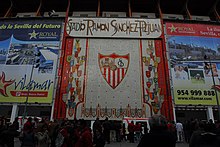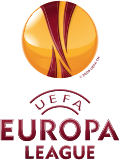Estadio Ramón Sánchez Pizjuán
| Estadio Ramón Sánchez Pizjuán | |
|---|---|
| La Bombonera de Nervión | |

|
|
| The Estadio Ramón Sánchez-Pizjuán (2005) | |
| Data | |
| place | Avenida Eduardo Dato 41005 Seville , Spain |
| Coordinates | 37 ° 23 '2.6 " N , 5 ° 58' 14.1" W |
| start of building | 2nd December 1956 |
| opening | September 7, 1958 |
| First game | 7 September 1958 Sevilla FC - Real Jaén 3-0 |
| Renovations | 1974, 1981, 1997, 2015-2016 |
| surface | Natural grass |
| architect | Manuel Muñoz Monasterio |
| capacity | 43,833 seats |
| playing area | 105 × 70 m |
| Societies) | |
| Events | |
|
|
The Estadio Ramón Sánchez-Pizjuán is a football stadium in the southern Spanish city of Seville , Autonomous Community of Andalusia . It currently offers 43,833 seats for spectators and is the sporting home of the Sevilla FC football club .
history
The Estadio Ramón Sánchez Pizjuán, named after Ramón Sánchez-Pizjuán, who was president of Sevilla FC from 1932 to 1941 and from 1948 to 1956 , was built between 1956 and 1957. On September 7, 1958, the new stadium opened with a friendly game between the future users of the arena, Sevilla FC, and Real Jaén . The final result of this first game in the new stadium was 3-0 for the top club from the southern Spanish city of Seville . Since that day it has been used by the aforementioned club as a venue for home games. The Sevilla football club was able to win the Spanish championship once in its more than 100-year history ( 1946 ) and is generally considered the best Spanish team behind FC Barcelona and Real Madrid. In addition to the championship, the club has won the Copa del Rey five times to date . In addition, they won the UEFA Cup twice in a row in 2006 and 2007 , making them the first and second team to succeed.
The Estadio Ramón Sánchez Pizjuán is also known as La Bombonera de Nervión . This nickname refers on the one hand to a stadium in Buenos Aires , the Estadio Alberto J. Armando, called La Bombonera , and on the other hand to the name of the stadium it replaced. In 1958, the Estadio Nervion was demolished as the home stadium of Sevilla FC in order to build a new larger stadium.
A series of renovations began in 2015 in the stadium. The venue has been modernized both inside and out. The tasks included a. the repair and waterproofing of the grandstands, which make the stands permanently water-repellent. The old red and white seating was replaced by new, mostly red, plastic seats. The video - scoreboards , players benches and the floodlights were replaced as well as the changing rooms and wheelchair accessible places rehabilitated. The first phase of the renovation was completed at the end of August 2015. In 2016, the redesign of the entrance area and the facade began. The exterior was wrapped in white mesh. The club's successes and trophies were displayed on the outside of the stands in the north and south. The outer skin of the main stand is adorned with the club's existing mosaic and legends of the club's players. The east side is reserved in memory of Antonio Puerta . The Sevilla FC player collapsed in the 31st minute of the game against Getafe CF on August 25, 2007 . After a cardiac arrest , he was admitted to the hospital in the intensive care unit, where he died three days later at the age of 22. Puerta suffered from an inherited and incurable heart disease known as arrhythmogenic right ventricular cardiomyopathy . As a highlight, the facade can be illuminated in different colors using LEDs .
At the end of October 2016, the previously installed lighting was tested for the first time. The facade was completed by the end of the year.
Football World Cup 1982
In 1982, the Estadio Ramón Sánchez Pizjuán was one of a total of 17 stadiums in which the matches of the twelfth football World Cup took place. At that time there was still room for 68,110 spectators in this stadium. Only two games were played in this stadium during the World Cup, but one of them went down in the history books of the World Cup. In the semifinals, Germany , two-time world champions, and France , one of the best teams in the world at the time, met. After it had been 1: 1 in the regular season, the extra time had to determine the finalist. Initially, France took the lead 3-1, but the Germans managed to turn the game and make it 3: 3 and thus the penalty shoot-out. Germany then won 5: 4 and moved into the final in Madrid , where they lost 3-1 to Italy at the Estadio Santiago Bernabéu . Another aspect of this Seville night (also known as the Seville thriller ) was the nasty foul by the German goalkeeper Toni Schumacher on the French Patrick Battiston in the 57th minute, which led to the image of the evil German being brought out again in France. Terms such as "Panzer", "Gestapo", "Schumacher SS" and "Nazis" were widespread in the French public in relation to Jupp Derwall's team.
There was also a group game at the Estadio Ramón Sánchez Pizjuán. Brazil defeated the Soviet Union 2-1.
Final of the European Champion Clubs' Cup 1985/86
Four years after the World Cup in Spain, the Estadio Ramón Sánchez Pizjuán was again the venue for a major game. On May 7, 1986 the final of the European Cup 1985/86 took place here, in which the Romanian champions Steaua Bucharest and his Spanish counterpart FC Barcelona faced each other. After ninety minutes and after extra time it was 0-0 goalless, a penalty shoot-out was necessary. Steaua's goalkeeper Helmuth Duckadam saved all four penalties given by Barça on his goal and Steaua won his first and so far only international title with a 2-0. It was also the first European club title for an Eastern European team. During this game the stadium was slightly overcrowded. Instead of the admitted 68,000 spectators, 70,000 watched the European Cup final.
2020/21 UEFA Europa League final
The home of FC Sevilla was announced by UEFA as the final location of the 2020/21 UEFA Europa League on September 24, 2019 .
panorama
Web links
- sevillafc.es: The stadium on the Sevilla FC website (Spanish)
- stadionwelt.de: Stadium guide
- europlan-online.de: Old and new pictures of the stadium
- stadiumdb.com: Estadio Ramón Sánchez Pizjuán (La Bombonera de Nervión) (English)
- stadiumguide.com: Estadio Ramón Sánchez Pizjuán (English)
Individual evidence
- ↑ stadionwelt.de: data on the stadium
- ↑ sevillafc.es: stadium capacity (Spanish)
- ↑ stadionwelt.de: Europa League winner modernizes stadium Article from June 23, 2015
- ↑ stadiumdb.com: Spain: Sevilla revamping their stadium Article from June 20, 2016 (English)
- ↑ stadionwelt.de: Stadium modernization goes ahead Article from August 28, 2015
- ↑ stadiumdb.com: Spain: Sevilla shows further stadium plans Article dated August 27, 2015
- ↑ stadionwelt.de: Sevilla FC: New stadium facade takes shape Article from October 26, 2016
- ↑ stadionwelt.de: Video: LED facade on the Seville Stadium Article from August 12, 2017
- ↑ St. Petersburg, Munich and London get CL final. In: stadionwelt.de. September 25, 2019, accessed September 25, 2019 .





